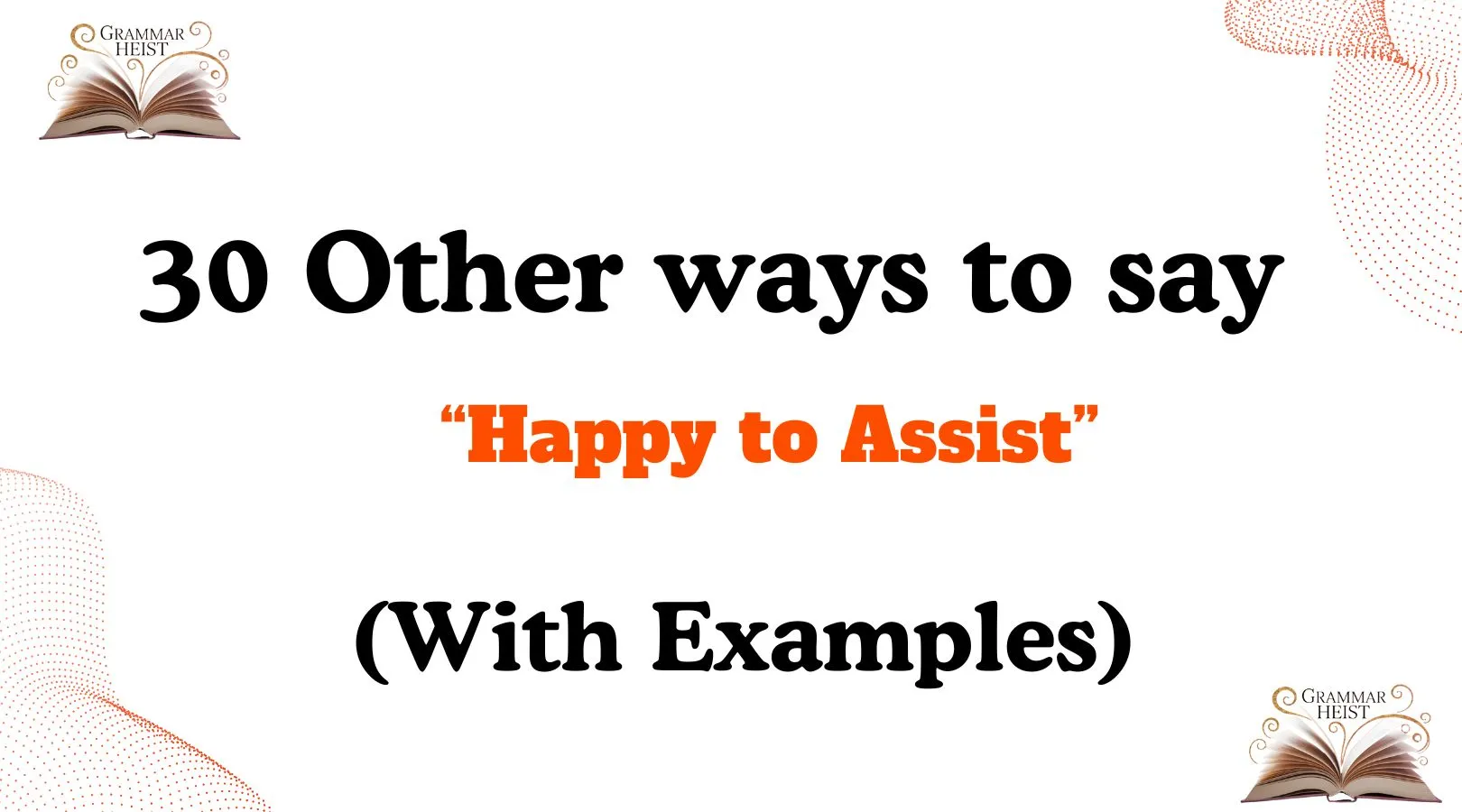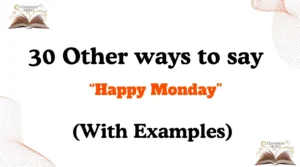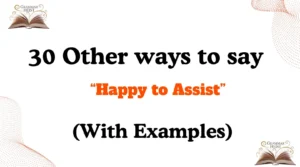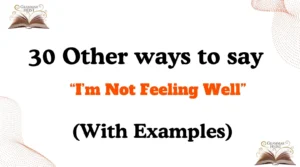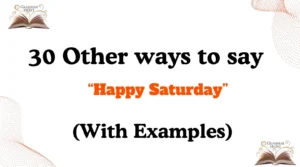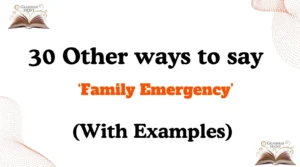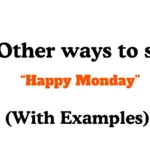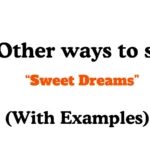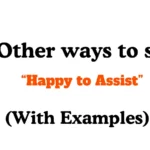Sometimes, saying “happy to assist” feels too routine, especially in professional emails or customer interactions. Finding the right words helps your message sound warm, caring, and human — not robotic or scripted. Whether you’re responding to a customer, a colleague, or a friend, choosing the right tone shows empathy, willingness, and genuine support.
In this guide, you’ll discover 30 other ways to say “happy to assist” — each with examples, tone, and a quick explanation to help you sound thoughtful, natural, and professional.
What Does “Happy to Assist” Mean?
The phrase “happy to assist” is a polite and positive way of saying you’re glad to help someone. It’s commonly used in customer service, work emails, or polite conversations to show readiness and willingness to support others.
It communicates professional kindness — a balance between helpfulness and courtesy.
Is It Professional or Polite to Say “Happy to Assist”?
Yes — “happy to assist” is both professional and polite. It works beautifully in customer support, emails, and service settings.
However, it can sometimes sound overused or too formal, depending on the situation. That’s why having some friendly and natural alternatives can make your response feel more authentic and engaging.
Pros and Cons of Saying “Happy to Assist”
Pros:
- Sounds polite and professional.
- Suitable for emails, chats, and formal messages.
- Creates a positive impression of helpfulness.
Cons:
- Can sound too formal or scripted.
- Lacks emotional warmth in casual exchanges.
- May feel repetitive if used often in customer service.
Key Takeaway
Replacing “happy to assist” with warmer or more conversational alternatives makes your tone more human and memorable. The key is to balance professionalism and friendliness, adapting your words to fit the situation naturally.
“Happy to Assist” Synonyms
- Glad to Help
- Happy to Help
- Pleased to Support
- It’s My Pleasure
- Always Here to Help
- Delighted to Assist
- I’m Here If You Need Anything
- It’s No Trouble at All
- I’m Glad You Reached Out
- You’re Very Welcome
- I’m Happy to Be of Service
- I’m Always Happy to Help Out
- I’m Glad I Could Help
- It Was My Pleasure to Help
- I’m Always Glad to Help
- Happy to Lend a Hand
- It’s the Least I Can Do
- I’m Here to Support You
- I’m Happy to Do My Part
- Don’t Mention It
- Anytime!
- That’s What I’m Here For
- I’m Honored to Help
- I’m Glad Everything Worked Out
- No Problem at All
- Consider It Done
- I’m Grateful I Could Help
- I’m Always Willing to Help
- It Was Great Helping You
- Anytime You Need Assistance, I’m Here
1. Glad to Help
Scenario: When offering help or responding to gratitude.
Examples:
- I’m glad to help anytime!
- Glad to help — let me know if you need more info.
- Always glad to help where I can.
Tone: Friendly and approachable.
Explanation: A relaxed and genuine phrase for both professional and casual situations.
2. Happy to Help
Scenario: A universal alternative suitable for most situations.
Examples:
- Happy to help, anytime!
- I’m happy to help if there’s anything else you need.
- Always happy to help where I can.
Tone: Warm and polite.
Explanation: Very similar to “happy to assist,” but feels softer and more natural.
3. Pleased to Support
Scenario: When you want to sound professional and composed.
Examples:
- I’m pleased to support this project.
- Pleased to support you with any questions.
- I’d be pleased to support your team further.
Tone: Formal and courteous.
Explanation: Excellent for business or corporate settings.
4. It’s My Pleasure
Scenario: Use after helping someone or providing a service.
Examples:
- It’s my pleasure!
- My pleasure — always glad to help.
- It’s my pleasure to be of assistance.
Tone: Warm and professional.
Explanation: Sounds polite and gracious, often used in hospitality or service industries.
5. Always Here to Help
Scenario: When you want to reassure ongoing support.
Examples:
- Always here to help if you need anything else.
- I’m always here to help — don’t hesitate to ask.
- Always here to help and happy to clarify further.
Tone: Supportive and friendly.
Explanation: Great for customer service or teamwork communication.
6. Delighted to Assist
Scenario: Use when expressing genuine enthusiasm.
Examples:
- I’m delighted to assist with your inquiry.
- Delighted to assist anytime you need.
- It’s a delight to assist you with this.
Tone: Polite and upbeat.
Explanation: Slightly formal but warm, perfect for client communication.
7. I’m Here If You Need Anything
Scenario: When offering future or continued help.
Examples:
- I’m here if you need anything else.
- Feel free to reach out — I’m here to help.
- I’m always here if you have questions.
Tone: Caring and approachable.
Explanation: Sounds personal and supportive, not mechanical.
8. It’s No Trouble at All
Scenario: When someone apologizes for asking for help.
Examples:
- It’s no trouble at all — happy to help.
- No trouble at all, I’m glad you reached out.
- Really, it’s no trouble — I’m happy to assist.
Tone: Gentle and kind.
Explanation: Ideal for reassuring clients or colleagues.
9. I’m Glad You Reached Out
Scenario: When someone asks for help or shares a problem.
Examples:
- I’m glad you reached out — let’s solve this together.
- So glad you asked, I can help with that.
- I’m really glad you reached out about this issue.
Tone: Empathetic and friendly.
Explanation: Expresses care and appreciation for communication.
10. You’re Very Welcome
Scenario: In response to “thank you.”
Examples:
- You’re very welcome!
- You’re most welcome — happy to help anytime.
- You’re welcome, it’s my pleasure.
Tone: Warm and courteous.
Explanation: Classic and simple — always appropriate.
11. I’m Happy to Be of Service
Scenario: When helping in a professional or formal context.
Examples:
- I’m happy to be of service.
- Always happy to be of service to your team.
- It’s an honor to be of service.
Tone: Formal and polite.
Explanation: Perfect for customer-facing or hospitality roles.
12. I’m Always Happy to Help Out
Scenario: When showing consistent willingness.
Examples:
- I’m always happy to help out!
- Always happy to help out where needed.
- Happy to help out again anytime.
Tone: Cheerful and warm.
Explanation: Feels sincere and friendly for recurring collaborations.
13. I’m Glad I Could Help
Scenario: When reflecting after assisting.
Examples:
- I’m glad I could help resolve that.
- Glad I could be of help to you.
- I’m just glad I could help out!
Tone: Genuine and thoughtful.
Explanation: Adds personal satisfaction to your reply.
14. It Was My Pleasure to Help
Scenario: When you want to sound heartfelt after helping.
Examples:
- It was my pleasure to help you.
- My pleasure to help, truly.
- It was my pleasure to assist with this matter.
Tone: Warm and kind.
Explanation: Great for thank-you replies or closing a conversation.
15. I’m Always Glad to Help
Scenario: Simple and polite for everyday use.
Examples:
- Always glad to help when I can.
- I’m always glad to help out.
- Glad to help anytime!
Tone: Natural and friendly.
Explanation: Perfect blend of professional and approachable.
16. Happy to Lend a Hand
Scenario: For teamwork or practical help.
Examples:
- Happy to lend a hand anytime.
- I’d be happy to lend a hand if needed.
- Always happy to lend a hand!
Tone: Friendly and cooperative.
Explanation: Sounds collaborative and supportive, great for teams.
17. It’s the Least I Can Do
Scenario: When someone thanks you sincerely.
Examples:
- It’s the least I can do!
- No problem at all, it’s the least I can do.
- Really, the least I can do for you.
Tone: Humble and kind.
Explanation: Expresses humility and willingness to help.
18. I’m Here to Support You
Scenario: When reassuring someone you’ll help them.
Examples:
- I’m here to support you in any way I can.
- Don’t worry — I’m here to support you through this.
- I’m always here if you need support.
Tone: Empathetic and sincere.
Explanation: Works beautifully in emotional or mentorship contexts.
19. I’m Happy to Do My Part
Scenario: For teamwork or shared projects.
Examples:
- I’m happy to do my part for the team.
- Always happy to do my part!
- Glad to contribute in any way I can.
Tone: Cooperative and optimistic.
Explanation: Encourages team spirit and collaboration.
20. Don’t Mention It
Scenario: Casual reply to gratitude.
Examples:
- Don’t mention it!
- Don’t mention it — happy to help.
- Really, it’s no big deal.
Tone: Relaxed and informal.
Explanation: Great for friendly or peer-to-peer conversations.
21. Anytime!
Scenario: Quick and easy response to thanks.
Examples:
- Anytime!
- Anytime, glad to help.
- Sure thing — anytime!
Tone: Casual and cheerful.
Explanation: Simple, friendly one-word reply that works everywhere.
22. That’s What I’m Here For
Scenario: When acknowledging your role or purpose in helping.
Examples:
- That’s what I’m here for!
- You’re welcome — that’s what I’m here for.
- Happy to help — that’s what I’m here for.
Tone: Lighthearted and positive.
Explanation: Adds humor and warmth, good for informal settings.
23. I’m Honored to Help
Scenario: When someone deeply values your help.
Examples:
- I’m honored to help.
- Truly honored to support you in this.
- It’s an honor to assist with this.
Tone: Respectful and heartfelt.
Explanation: Best for meaningful or significant assistance.
24. I’m Glad Everything Worked Out
Scenario: After your help leads to a good outcome.
Examples:
- I’m glad everything worked out!
- Happy it turned out well.
- So glad to hear it went smoothly.
Tone: Positive and reassuring.
Explanation: Ends the conversation on a warm and supportive note.
25. No Problem at All
Scenario: Casual way to downplay effort.
Examples:
- No problem at all!
- No problem — glad to help.
- Absolutely no problem, anytime.
Tone: Friendly and casual.
Explanation: Ideal for everyday or relaxed conversations.
26. Consider It Done
Scenario: When you want to sound confident and proactive.
Examples:
- Consider it done!
- Absolutely, consider it handled.
- You got it — consider it done.
Tone: Confident and helpful.
Explanation: Shows efficiency and reliability.
27. I’m Grateful I Could Help
Scenario: When your help had a positive impact.
Examples:
- I’m grateful I could help in some way.
- Truly grateful I was able to assist.
- Glad I could be helpful.
Tone: Reflective and heartfelt.
Explanation: Adds emotional authenticity and warmth.
28. I’m Always Willing to Help
Scenario: When showing readiness to assist again.
Examples:
- Always willing to help where needed.
- I’m always willing to lend a hand.
- Happy to help whenever you need.
Tone: Kind and proactive.
Explanation: Shows dedication and reliability.
29. It Was Great Helping You
Scenario: When ending a friendly interaction.
Examples:
- It was great helping you today.
- Always nice to help out!
- It was great assisting with this.
Tone: Friendly and conversational.
Explanation: Adds a personal closing touch to your message.
30. Anytime You Need Assistance, I’m Here
Scenario: Offering future help confidently.
Examples:
- Anytime you need assistance, I’m here.
- I’ll always be here if you need support.
- Reach out anytime — I’m happy to help.
Tone: Professional and reassuring.
Explanation: Excellent for long-term client or colleague relationships.
FAQs About Saying “Happy to Assist”
1. What does “Happy to Assist” mean?
“Happy to assist” means you’re glad or willing to help someone. It’s a polite, professional way of showing support, often used in emails, customer service, and formal communication.
2. Is it professional to say “Happy to Assist”?
Yes — “Happy to assist” is perfectly professional. It shows politeness and helpfulness. However, if you use it too often, it can sound repetitive, so it’s good to mix in alternatives like “Glad to help” or “Pleased to support.”
3. What can I say instead of “Happy to Assist” in an email?
Here are a few polished alternatives for email communication:
- I’m glad to help.
- It’s my pleasure.
- I’m always here to support.
- Pleased to assist you.
- Happy to help anytime.
These sound friendly, confident, and professional while keeping your tone genuine.
4. How can I sound more natural when offering help?
To sound more natural, use simple and conversational phrases that match your tone and relationship with the recipient. For example:
- “Sure thing — happy to help!” (casual)
- “I’m glad to assist with that.” (professional)
- “No trouble at all.” (friendly)
Adding warmth and personal touch always helps your words feel more authentic.
5. When should I avoid saying “Happy to Assist”?
Avoid saying “Happy to assist” in very casual conversations or when the tone might feel too formal. In those cases, use lighter alternatives like “Glad to help” or “No problem at all.”
6. How can I make “Happy to Assist” sound more genuine?
Add specific details or emotion to your response. Instead of just “Happy to assist,” you can say:
- “Happy to assist — I know this was time-sensitive.”
- “Happy to help, I’m glad you reached out.”
- “Always happy to assist, that’s what teamwork is for.”
Personal touches make your gratitude and willingness feel more sincere.
7. Can I use “Happy to Assist” in customer service emails?
Absolutely! It’s one of the most common phrases used in customer support, hospitality, and service industries. Example:
“Thank you for contacting us. We’re always happy to assist with any concerns.”
Just remember to sound genuine — robotic or copy-paste responses can feel impersonal.
8. What’s the difference between “Happy to Assist” and “Happy to Help”?
Both mean the same thing, but “Happy to help” feels friendlier and more conversational, while “Happy to assist” sounds a bit more formal and polished. Use “assist” in professional or official contexts, and “help” in friendly or casual ones.
9. Can I use these phrases in professional chat or Slack messages?
Yes! You can adapt the tone depending on the context.
- Formal: “Pleased to support — please let me know if you need more info.”
- Casual: “Glad to help! Just ping me if anything comes up.”
Adjust the warmth of your words based on who you’re speaking to.
10. What’s the best alternative to “Happy to Assist” for business emails?
The best alternative depends on the tone you want:
- Polite and professional: “Pleased to support”
- Friendly yet formal: “Glad to help”
- Warm and personal: “It’s my pleasure”
- Confident and proactive: “Consider it done”
Each carries the same helpful spirit but gives your message a fresh, natural feel.
FAQs About Saying “Happy to Assist”
1. What does “Happy to Assist” mean?
“Happy to assist” means you’re glad or willing to help someone. It’s a polite, professional way of showing support, often used in emails, customer service, and formal communication.
2. Is it professional to say “Happy to Assist”?
Yes — “Happy to assist” is perfectly professional. It shows politeness and helpfulness. However, if you use it too often, it can sound repetitive, so it’s good to mix in alternatives like “Glad to help” or “Pleased to support.”
3. What can I say instead of “Happy to Assist” in an email?
Here are a few polished alternatives for email communication:
- I’m glad to help.
- It’s my pleasure.
- I’m always here to support.
- Pleased to assist you.
- Happy to help anytime.
These sound friendly, confident, and professional while keeping your tone genuine.
4. How can I sound more natural when offering help?
To sound more natural, use simple and conversational phrases that match your tone and relationship with the recipient. For example:
- “Sure thing — happy to help!” (casual)
- “I’m glad to assist with that.” (professional)
- “No trouble at all.” (friendly)
Adding warmth and personal touch always helps your words feel more authentic.
5. When should I avoid saying “Happy to Assist”?
Avoid saying “Happy to assist” in very casual conversations or when the tone might feel too formal. In those cases, use lighter alternatives like “Glad to help” or “No problem at all.”
6. How can I make “Happy to Assist” sound more genuine?
Add specific details or emotion to your response. Instead of just “Happy to assist,” you can say:
- “Happy to assist — I know this was time-sensitive.”
- “Happy to help, I’m glad you reached out.”
- “Always happy to assist, that’s what teamwork is for.”
Personal touches make your gratitude and willingness feel more sincere.
7. Can I use “Happy to Assist” in customer service emails?
Absolutely! It’s one of the most common phrases used in customer support, hospitality, and service industries. Example:
“Thank you for contacting us. We’re always happy to assist with any concerns.”
Just remember to sound genuine — robotic or copy-paste responses can feel impersonal.
8. What’s the difference between “Happy to Assist” and “Happy to Help”?
Both mean the same thing, but “Happy to help” feels friendlier and more conversational, while “Happy to assist” sounds a bit more formal and polished. Use “assist” in professional or official contexts, and “help” in friendly or casual ones.
9. Can I use these phrases in professional chat or Slack messages?
Yes! You can adapt the tone depending on the context.
- Formal: “Pleased to support — please let me know if you need more info.”
- Casual: “Glad to help! Just ping me if anything comes up.”
Adjust the warmth of your words based on who you’re speaking to.
10. What’s the best alternative to “Happy to Assist” for business emails?
The best alternative depends on the tone you want:
- Polite and professional: “Pleased to support”
- Friendly yet formal: “Glad to help”
- Warm and personal: “It’s my pleasure”
- Confident and proactive: “Consider it done”
Each carries the same helpful spirit but gives your message a fresh, natural feel.
Conclusion
Saying “happy to assist” is polite and professional, but variety makes communication feel warmer, more natural, and more human. Whether you’re writing to a client, colleague, or customer, these alternatives express the same helpful attitude with a touch of personality and care.

Emma Brooke is a passionate advocate for effective communication and language mastery. As a dedicated professional in the field of grammar and writing, Emma brings a wealth of knowledge and expertise to those seeking to improve their linguistic skills. With a focus on clarity, precision, and style, Emma Brooke is committed to helping individuals refine their language use to communicate confidently and effectively.
